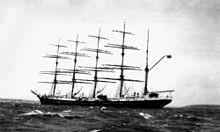- København (ship)
-
The Copenhagen (København) was a Danish sailtraining vessel rigged as a five-masted steel auxiliary barque (1921–1929). It was, according to Alan Villiers, the largest and finest sailing vessel in the world at the time it vanished.
It was built by the firm of Ramage and Fergusson at Leith in Scotland (number 242), begun in 1913 but not completed until March 24, 1921, and was constructed for the Danish East Asiatic Company as a training ship. It had an auxiliary diesel motor. It also had long range radio equipment. Villiers points out it was a really well built, strong ship that would have not been in such immediate danger that it could not send off any distress call. She was over 354 feet long with a 49 foot beam, and 28 feet 7 inches in depth. Without cargo she displaced 4,219 tons. Her gross tonage was 3,965 tons and her deadweight capacity 5,200 tons. Her overall length was 430 feet. Her loaded draught was 24 feet. Her auxiliary motor gave a speed of 6 knots. However the ship was meant to be a sailing ship, and the auxiliary motor only meant for calm seas or ports. Her holds were bulkheaded by thwartships watertight steel partitions, which again should have made it difficult to sink her. Copenhagen left Leith in September 1921. Before sailing from Copenhagen on her first voyage, 10,000 people visited the ship (including the King and Queen of Denmark).
The ship disappeared on route from Buenos Aires to Australia sometime between December 1928 and January 1929. At the time of the last voyage (her tenth voyage) her Captain was Hans Ferdinand Andersen. She left Buenos Aires on December 14, 1928. Up to a week after the she sailed she had a working radio, because she was in touch briefly with a steamer, William Blumer. Nothing further was heard from her. Due to the length of the voyage to Australia the lack of word from the ship was not causing anxiety, but after mid-February the concerns of the Danish East Asiatic Company grew. No reports of a sighting from any vessel of the missing ship was found, and conditions (which included some iceberg reports) were not really abnormally bad. Searches were made of out of the way islands such as Kerguelen were made but nothing found. A report was made by a missionary on the island of Tristan da Cunha who saw a large five masted ship (two masts were broken) drifting near the island on January 21, 1929. Subsequently wreckage was seen drifting near the island. Later this sighting was put into question when a four masted Finnish barque was reported as having sailed near Tristan da Cunha. Eventually an inquiry decided that it was a sudden act of God, that was so fast as to prevent the sending of any message or launching of a lifeboat.
Sixty hands were lost, of which fifteen were crew and forty five were cadets aged down to 16.[1]
In 1935, along the southwest coast of Africa, human remains and the remains of a lifeboat were found partly buried in the sand. These may have come from the Copenhagen.[1]
In his 1952 book Great Gales and Dire Disasters, Edward Rowe Snow includes details of the København incident in one of the chapters, and mentions that he once received a letter years after the disappearance of the ship from a Canadian reader stating that an acquaintance of the reader was beachcombing and found a fragment of wood that turned out to be a section of a lifeboat with the word "København" on it.
References
- Bruus Jensen, Palle, og Erik Jensen, Skoleskibet København: historie, forlis, tragedie. Kbh., 2005. (ISBN 8-712-04178-5)
- Jens Kusk Jensen: Håndbog i praktisk sømandskab. Kbh., 1924, Foreningen til Søfartens Fremme (ISBN 8-714-28284-4)
- ^ a b "Kobenhavn (+1928)". http://www.wrecksite.eu/wreck.aspx?58328. Retrieved 2009-06-23.
- Alan Villiers, Posted Missing: The Story of Ships Lost Without Trace in Recent Years New York: Charles Scribners' Sons, 1956, illus., p. 195-214.
External links
Categories:- Shipwrecks in the Atlantic Ocean
- Barques
- Maritime incidents in 1928
- Maritime incidents in 1929
- Missing ships
- Individual sailing vessels
- Sailing ships
- Tall ships of Denmark
- School ships
- Individual ship or boat stubs
Wikimedia Foundation. 2010.

